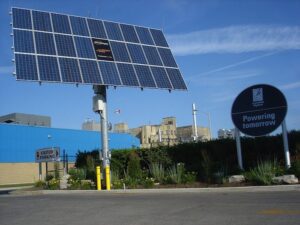 Fallible solutions to modern power and electricity problems are few and far between; fraught with potholes and lined with difficulty. The political war between realising a more ecological future is at loggerheads with realising an economical one; the jury still missing and at large about how to move forward.
Fallible solutions to modern power and electricity problems are few and far between; fraught with potholes and lined with difficulty. The political war between realising a more ecological future is at loggerheads with realising an economical one; the jury still missing and at large about how to move forward.
Centralised Generation
In our current climate of centralised generation (CG), the national grid is supplemented with electricity from large power hubs. CG operates as a consolidated location which provides power for large conurbations and metropolitan areas nearby, but can also be employed to service a wider country of sparse population scattering. CG hubs are traditionally operated by vast fossil-fuel boilers, running on natural gas and/or coal. In rarer cases large hydro or nuclear centres operate in the same format, using the fires to produce steam which drive turbines.
Distributed Generation
Murmurs of discontent have come forward with ideas of examining some older technologies. If we can’t find a way to move forward into the green revolution with the way that we’re currently operating, perhaps we need to look at what we have uncovered in the past; fresh with a more knowledgeable sight. Distributed generation (DG) was a popular recourse for power in years gone by, but has had a turbulent time in recent decades. DG operates at smaller developments, generating smaller amounts of power but providing it a lot nearer to the consumer.
Is It Feasible?
Distributed generation has been enjoying a revival in the minds of green thinkers recently, with views to re-introduce the concept. The reduction of costing barriers in the technology has meant the DGs have taken on the “in case” function. Small DG installations operate as stand-by and peak units, operating in fluctuations of high price or high consumption. They improve the reliability of power in the locale and offer a cheaper alternative to the national grid, not to mention eliminating the recovery time behind a failure.
Due to their small footprint and quick production turnaround, DG units have dropped in manufacture, transport and installation cost. They’re notoriously un-site specific and can be utilised in any location, becoming particularly useful for the revenue in locations where there isn’t an excess in demand.
With an eye on the green credentials of DG, its revival can also be linked to the use in sustainable technology. The generation of power through fossil fuel has always featured the wasted by-product of heat, but by producing this so close to the end-user; one can channel the heat into homes and businesses and negate the reliance on electricity to provide heating.
Additionally, centralised generation comes with its significant drawbacks. Distributing electricity over such a vast area is staggeringly expensive, with up to 30 percent of the stations costs being taken up by the deliverance. The driving price of the transmission is largely down to the conversion losses; when the electricity is changed from different voltage levels when travelling into different networks. Power is naturally lost over long distances through inefficient cables and much electricity goes unaccounted for.
Distributed generation is not, however, without its critics. There is a significant lack of redundancy protection when power is being created throughout a small network. A large-scale failure of a centralised generation hub can be supplemented by nearby sister stations, and thus distributed to the consumers. The breakdown of a localised unit, unconnected to the national grid, cannot enjoy the same benefits and so many business and industrial users will be discouraged by the lack of reliability and security.
Tackling The Issues
The future of DG lies in its integration into smart grid technology, to reduce the drawbacks of its features. The new collection of design ideas is a complex collection of different technologies, which combine to overcome the negatives of traditional power modes and integrate the positives. With reliance on the end user to micro manage a virtual power plant in or near their home, the load bearing is taken from the national grid and we can slowly begin to make the migration towards greener living.
Smart grid technology would operate in a combination of methodology. Homes could features wind turbines and solar pv panels in suitable locations, hybrid plug-in vehicles and the ability to store the created power of distributed generation. An installed control interface and advanced metering would allow the consumer to both monitor and meet their power output, in a bid to save both money and the environment.
What Next?
The technology already exists for smart grid, but its implementation is still in the blurry middle distance whilst we maintain our reliance on centralised generation of power. The integration of a number of different products will require time, effort and patience on all levels; from producer to consumer.
But if the solution is there, and the possibility is ripe; what reason is there not to grasp it?
——————-
Lewis MacNulty is a Electrical Engineer, Green Entrepreneur and author of numerous articles on green technology, eco-economics and enviro-politics. He is one of the leading engineers at WDSGreenEnergy, a leading green technology supplier Find WDS Green Energy on Facebook and follow WDS Green Energy’s twitter feed.
Related articles







 Annual Renewable Distributed Energy Generation Installations Will Nearly Triple by 2017, Forecasts Pike Research
Annual Renewable Distributed Energy Generation Installations Will Nearly Triple by 2017, Forecasts Pike Research
